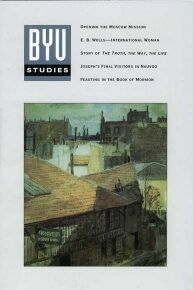Harwood and Haag Paint Paris
Article
Contents
[*** graphic omitted; see PDF ***]
Herman Haag, Sketch of Notre Dame. Pencil on paper, from sketchbook, 4″ × 6″, 1891. Courtesy Museum of Church History and Art.
Among the thousands of American artists who journeyed to Paris in the late 1800s were two Utah men, James Taylor Harwood (1860–1940) and Herman Haag (1871–1895). Paris offered many advantages not available in the relatively young and predominantly rural Utah—superior training, honors regularly given to artists, art galleries, cosmopolitan attitudes, and artistic experimentation. And the scenery itself was inspiring. Harwood described its potential in an 1888 letter: “We passed through some very lovely sketching country here. The harvest fields were very interesting in color and composition pictures [are] everywhere. This is truly a great city.”1
Harwood’s desire for training took him first from his hometown of Lehi, Utah, to the California School of Design in San Francisco. The gold medal for drawing that he won for his work there encouraged in him a desire to study in Europe. He obtained funds for his first journey to Paris by teaching art in Salt Lake City for two years, auctioning over one hundred paintings and drawings, and, for his second year, borrowing money from Dr. Heber J. Richards, his future father-in-law. On September 8, 1888, he arrived in Paris and enrolled in the Julian Academy. He was eventually joined by nine other Utahns.2 In 1890, Harwood left Paris for Utah, where he again taught art, this time to earn money to get married. A year later, he returned to Paris, married Harriett Richards, and continued his studies. In 1892, he had two paintings accepted by the French Salon, the first Utahn to receive this prestigious honor. The painting reproduced on the front cover of this issue was painted during Harwood’s third (1903) trip to Paris.
When Harwood made his second trip to Paris, he was accompanied by his student Herman Haag, a German emigrant whom he had convinced to study in Europe. Haag’s study was financed by the LDS Church, which had already sent four other “art missionaries” from Utah to Paris to develop their talents in preparation for decorating the Salt Lake Temple and otherwise serving their church. Haag, too, reveled in Paris:
I don’t know of any other city which loves the beautiful and admires art more than Paris does. . . . It is a great contrast to come from such a quiet place as Utah into such a city as Paris is to-day [sic]. . . . I am glad to have the privilege of thus getting acquainted with the world, it enlarges your mind and you see and learn more than you ever thought of, of course only my spare moments I spent for this kind of observation, I know what I have come here for, and have it on my mind continually to make the best use of my time.3
When Haag was twelve, he had suffered from a serious illness and never fully recovered. Nevertheless, he kept up with the rigorous Julian Academy routine of studio drawing and classes from 8 a.m. to 10 p.m. He also found time to sketch scenery, including the view of Notre Dame preceding this article. His fellow art missionary, John B. Fairbanks, noted that, in spite of being a cripple, Haag was progressing. That improvement eventually garnered Haag an award from the Julian Academy for his drawing John the Baptist Presents Christ before the People. Three years later, he died. He was only twenty-four.
About the author(s)
Doris R. Dant is Executive Editor of BYU Studies. Linda Jones Gibbs is Senior Curator at the Museum of Art, Brigham Young University.
Notes
1. William Robert South, “The Life and Art of James Taylor Harwood, 1860–1940” (master’s thesis, University of Utah, 1986), cited in Linda Jones Gibbs, Harvesting the Light: The Paris Art Mission and Beginnings of Utah Impressionism (Salt Lake City: The Church of Jesus Christ of Latter-day Saints, 1987), 11.
2. The others were Cyrus Dallin; John Willard Clawson; Harwood’s wife, Harriet Richards; and the art missionaries John Hafen, Lorus Pratt, John B. Fairbanks, Edwin Evans, and Herman Haag.
3. Letter from Herman Haag to his sister Louise, June 15, 1891, cited in Gibbs, Harvesting the Light, 28.
- The Power of Combination: Emmeline B. Wells and the National and International Councils of Women
- Out of Obscurity: The Emergence of The Church of Latter-day Saints in “That Vast Empire” of Russia
- The Story of The Truth, The Way, The Life
- Taste and Feast: Images of Eating and Drinking in the Book of Mormon
- Harwood and Haag Paint Paris
Articles
- John C. Calhoun, Jr., Meets the Prophet Joseph Smith Shortly before the Departure for Carthage
Documents
- The Improvisor
Creative Art
- Facing Mirrors
- Reflections of Stellar Ecology
- Walking Home from School
- Lonetree
- A Man of Battles Braids His Daughters’ Hair
Poetry
- The Proper Edge of the Sky: The High Plateau Country of Utah
- The Mormons’ War on Poverty: A History of LDS Welfare, 1830–1990
- Three books about women
- Confronting Abuse
Reviews
- Unpublished Revelations of the Prophets and Presidents of The Church of Jesus Christ of Latter-day Saints
- The Heavens Are Open: The 1992 Sperry Symposium on the Doctrine and Covenants and Church History
- Keepers of the Flame: Presidents of the Young Women
Book Notices
- Index, Volume 33
Indexes
Purchase this Issue
Share This Article With Someone
Share This Article With Someone


